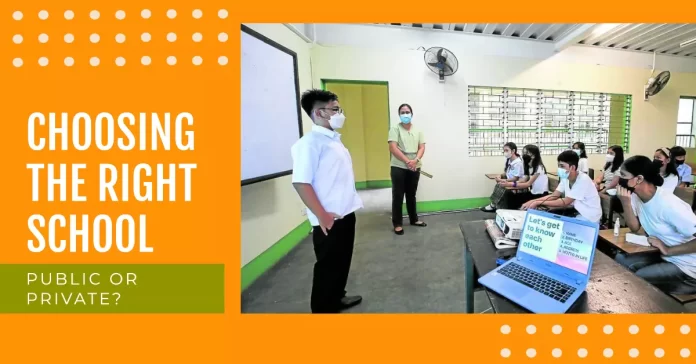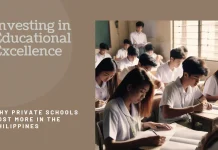In the Philippines, choosing the right school for your child is a crucial decision that can significantly impact their academic and personal development. One of the primary choices parents face is between public and private schools. Both institutions have unique characteristics, advantages, and disadvantages, making it essential to compare them to make an informed choice that aligns with your child’s needs and family’s preferences.
Public Schools in the Philippines
Public schools in the Philippines are government-funded educational institutions. They aim to provide free education to all Filipino students. Here are some key points to consider when evaluating public schools:
- Accessibility: Public schools are widespread, especially in urban areas, making them easily accessible for many students. They are often situated within the community, reducing commuting times.
- Cost: The government funds public schools, making tuition typically Free. However, there may still be some minor fees for various purposes.
- Diversity: Public schools enroll a diverse student population, offering opportunities for students to engage with peers from various backgrounds.
- Curriculum: Public schools adhere to the national curriculum established by the Department of Education (DepEd). The standardized curriculum guarantees a consistent education nationwide.
- Class Size: Larger class sizes in public schools, stemming from high demand, can impact the student-teacher ratio and the level of individualized attention.
- Facilities: Public schools frequently encounter difficulties keeping their facilities and resources.
Private Schools in the Philippines
Private schools, on the other hand, are not government-funded and are managed by individuals or organizations. They provide a distinct set of features:
- Quality: Private schools in the Philippines are known for their commitment to quality education. They usually have well-established reputations for academic excellence.
- Class Size: Private schools usually have smaller student numbers, facilitating personalized attention and interactive learning experiences.
- Curriculum: Private schools can offer a more diverse and specialized curriculum. Some may follow international programs, religious-based education, or alternative teaching methods.
- Cost: Private schools charge tuition fees that can vary significantly. Some private schools are more affordable, while others cater to higher-income families.
- Facilities: Private schools often have better-maintained facilities, libraries, laboratories, and extracurricular resources.
- Extracurricular Activities: Private schools offer a broader range of extracurricular activities, including sports, arts, and clubs.
Comparing Quality Education
When comparing quality education between public and private schools, several factors come into play:
- Quality of Teachers: Both public and private schools can employ highly qualified and dedicated teachers. It’s essential to research and inquire about the teaching staff of each school you’re considering.
- Academic Performance: Examine the academic achievements of the schools. Private schools may have a competitive edge, but some public schools have a long history of producing successful graduates.
- Extracurricular Opportunities: Consider your child’s interests and look for schools that offer relevant extracurricular activities. Private schools often have more options in this regard.
- Financial Considerations: Your budget is a crucial factor. While public schools are generally more affordable, some private schools offer scholarships and financial aid.
- Location: The proximity of the school to your home can significantly impact your child’s daily routine and commute.
- Parental Involvement: The level of parental involvement in the school community can also influence your child’s experience.
Conclusion
The choice between public and private schools in the Philippines should align with your family’s values, budget, and your child’s unique needs. Both options can provide quality education, but the approaches and resources may differ. Take the time to visit schools, talk to teachers, and gather information to make an informed decision that ensures your child’s academic success and personal growth.
Frequently Asked Questions (FAQs)
What are the main differences between public and private schools in the Philippines?
Public schools are government-funded, providing free education, while private schools are privately funded and require tuition fees.
How much is the tuition in a private school in the Philippines?
Tuition fees in private schools can vary significantly, with some being more affordable and others more expensive.
Are public schools in the Philippines completely free?
Yes, public schools in the Philippines typically do not charge tuition, making education accessible to a broader population.
Do public schools have larger class sizes than private schools?
Yes, public schools often have larger class sizes due to high demand, which can affect the student-teacher ratio and individualized attention.
What are the advantages of sending a child to a public school in the Philippines?
Public schools attract a diverse student population, offering opportunities for students to interact with peers from different backgrounds.
How do private schools in the Philippines maintain smaller class sizes?
Private schools typically maintain smaller student sizes to provide more personalized attention and interactive learning experiences.
Can students from public and private schools interact outside of the classroom?
Yes, students from both public and private schools can interact and build friendships outside of the classroom, fostering social diversity.
How does the curriculum differ between public and private schools in the Philippines?
Public schools follow the national curriculum set by the Department of Education (DepEd), ensuring consistency in education across the country. Private schools have the flexibility to design their own curricula, which may include additional programs and subjects.











